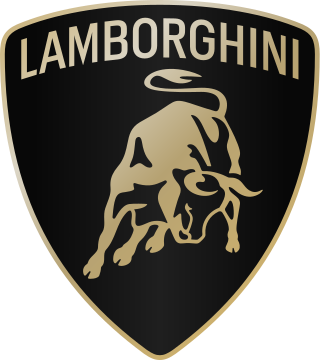
Automobili Lamborghini S.p.A. is an Italian manufacturer of luxury sports cars and SUVs based in Sant'Agata Bolognese. The company is owned by the Volkswagen Group through its subsidiary Audi.
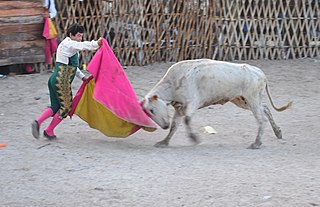
A bullfighter is a performer in the activity of bullfighting. Torero or toureiro, both from Latin taurarius, are the Spanish and Portuguese words for bullfighter and describe all the performers in the activity of bullfighting as practised in Spain, Portugal, Mexico, Peru, France, Colombia, Ecuador, Venezuela and other countries influenced by Portuguese and Spanish culture. The main performer and leader of the entourage in a bullfight, and who finally kills the bull, is addressed as maestro (master), or with the formal title matador de toros. The other bullfighters in the entourage are called subalternos and their suits are embroidered in silver as opposed to the matador's gold. They include the picadores, rejoneadores, and banderilleros.

Luis Miguel González Lucas, better known as Luis Miguel Dominguín, was a bullfighter from Spain and the son of the noteworthy bullfighter, Domingo Dominguín. Dominguín adopted his father's name to gain popularity.

Manuel Benítez Pérez, more commonly known as El Cordobés, is a Spanish bullfighter, matador, and actor active in the 1960s who brought an unorthodox acrobatic and theatrical style to the bullring.

Manuel Laureano Rodríguez Sánchez, known as Manolete, was a Spanish bullfighter.

Ferruccio Lamborghini was an Italian automobile designer, soldier, inventor, mechanic, engineer, winemaker, industrialist, and businessman who created Lamborghini Trattori in 1948 and the Automobili Lamborghini in 1963, a maker of high-end sports cars in Sant'Agata Bolognese.
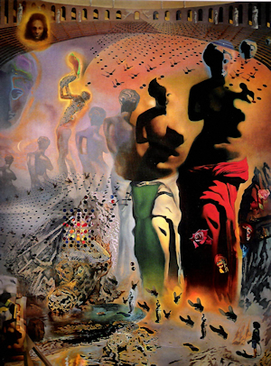
The Hallucinogenic Toreador is a 1969–1970 multi-leveled oil painting by Salvador Dalí which employs the canons of his particular interpretation of surrealist thought. It is currently being exhibited at the Salvador Dalí Museum in St. Petersburg, Florida.

The Lamborghini Espada is a 4-seat grand touring coupé built by Italian car manufacturer Lamborghini between 1968 and 1978.

The Lamborghini Islero is a grand tourer produced by Italian automaker Lamborghini between 1968 and 1969. It was the replacement for the 400 GT and featured the Lamborghini V12 engine. The car debuted at the 1968 Geneva Auto Show.

Manolete, also known as The Passion Within in the United Kingdom, Blood and Passion in Canada, and A Matador's Mistress in the United States, is a 2008 biopic of bullfighter Manuel Laureano Rodríguez Sánchez, better known as "Manolete". The film was written and directed by Menno Meyjes. This is the first film from HandMade Films since Lock, Stock and Two Smoking Barrels (1998).

Pasodoble is a fast-paced Spanish military march used by infantry troops. Its speed allowed troops to give 120 steps per minute. This military march gave rise recently to a modern Spanish dance, a musical genre including both voice and instruments, and a genre of instrumental music often played during bullfight. Both the dance and the non martial compositions are also called pasodoble.

The Plaza de Torosde Acho is the premier bullring in Lima, Peru. Located beside the historical center of the Rímac District, the plaza is classified as a national historic monument. It is the oldest bullring in the Americas and the second-oldest in the world after La Maestranza in Spain. It opened on 30 January 1766.

The Spanish Fighting Bull is an Iberian heterogeneous cattle population. It is exclusively bred free-range on extensive estates in Spain, Portugal, France and Latin American countries where bull fighting is organized. Fighting bulls are selected primarily for a certain combination of aggression, energy, strength and stamina. In order to preserve their natural traits, during breeding the bulls rarely encounter humans, and if so, never encounter them on foot.

Spanish-style bullfighting is a type of bullfighting that is practiced in Spain, Mexico, Colombia, Ecuador, Venezuela, Peru, as well as in parts of southern France and Portugal. This style of bullfighting involves a physical contest with humans attempting to publicly subdue, immobilize, or kill a bull. The most common bull used is the Spanish Fighting Bull, a type of cattle native to the Iberian Peninsula. This style of bullfighting is seen to be both a sport and performance art. The red colour of the cape is a matter of tradition – bulls are color blind. They attack moving objects; the brightly-colored cape is used to mask blood stains.
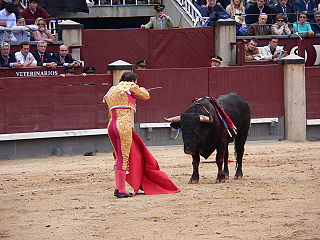
Bullfighting is a physical contest that involves a bullfighter attempting to subdue, immobilize, or kill a bull, usually according to a set of rules, guidelines, or cultural expectations.
Paco Cano Lorenza, also known as Canito, was a Spanish photojournalist from Valencia, who specialized in torero photography.

Lupe Sino was a Spanish actress.
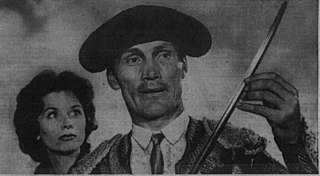
"The Death of Manolete" was an American television play broadcast live on September 12, 1957, as part of the CBS television series, Playhouse 90. It was the first episode of the second season and featured Jack Palance in the role of Manolete. Producer Martin Manulis later called it "the classic clinker of all time."
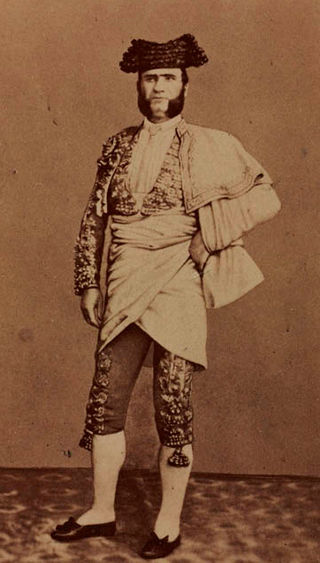
José Dámaso Rodríguez y Rodríguez, known as Pepete, was a Spanish bullfighter in the mid-19th century. He was the first notable matador known by this nickname.

Project Islero was an attempted Spanish nuclear program. Created by Agustín Muñoz Grandes and Guillermo Velarde in 1963, the project lasted from the middle stages of Francisco Franco's rule into the beginning of the democratic transition. Although the project never developed a nuclear weapon due to being ended prematurely, the country possessed the capabilities to both design and manufacture the necessary components needed for a hydrogen bomb. The project was cancelled due to American pressures in 1981, although only formally ended in 1987 under Felipe González.



















